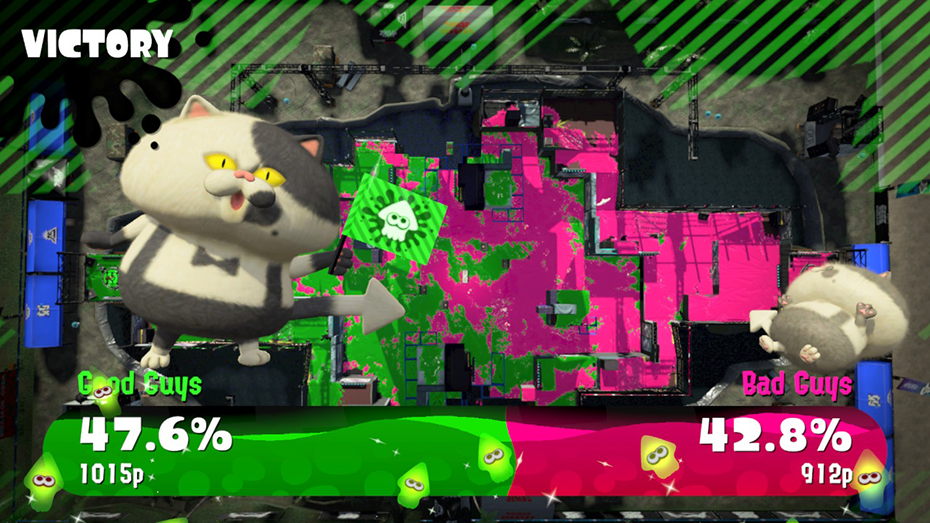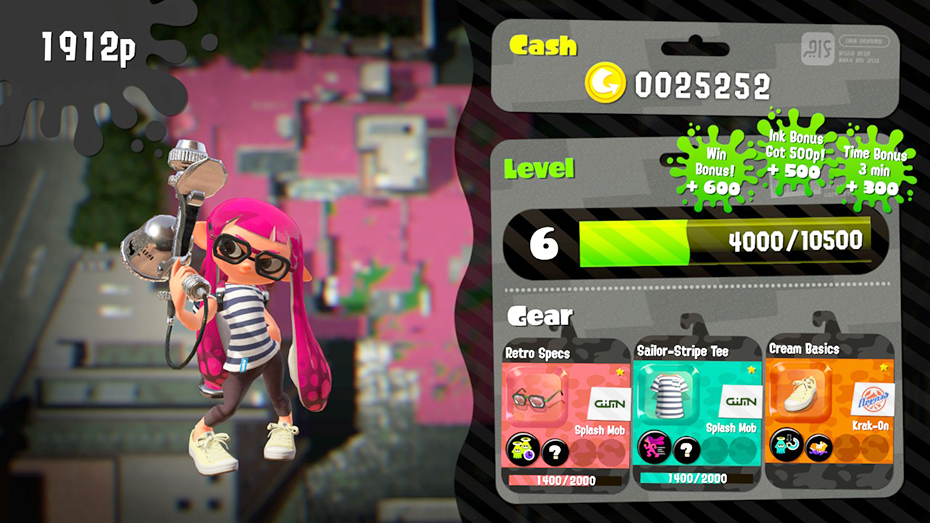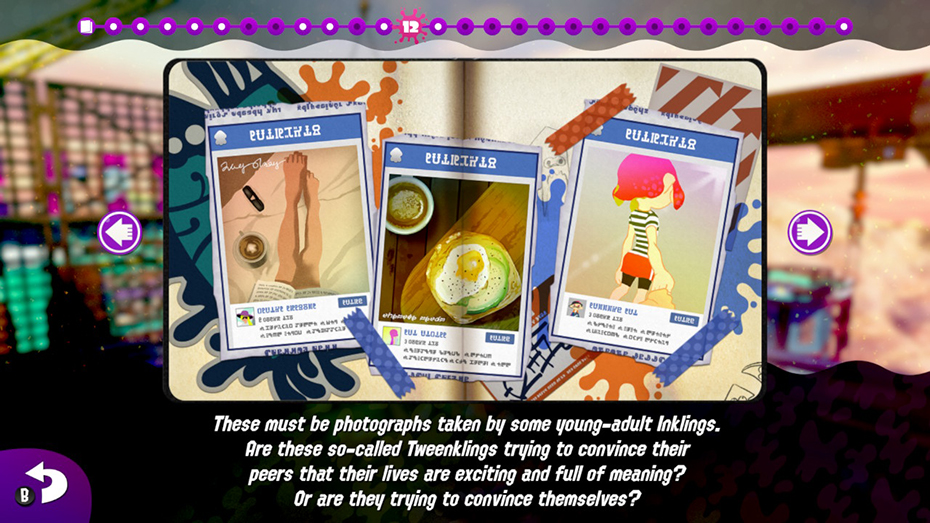Splatoon 2 Is More of the Same—and Nothing Could Be Better
Some might criticize Splatoon 2 for simply being a visual update on the first game with a few new maps, weapons and gameplay modes. They wouldn't be entirely wrong, but I say why mess with a good thing?
The first Splatoon was a standout game on a system overlooked even by many lifelong Nintendo fans, the Wii U. The game turned traditional third-person shooters on their heads, replacing bullets with streams of colorful paint and its soldiers into kids who can transform into squids, running and gunning in their human forms or swiftly swimming through pools of ink as squids.
The game was frenetic and friendly for anyone who picked it up, and with intuitive gyroscope controls, it was tons of fun, too. Now that its sequel is coming out on the much more popular Nintendo Switch, I'm thrilled that a lot more people are going to be exposed to this game that's so near and dear to my heart.
Splatoon's main gameplay mode is Turf War, in which two teams of four head off against one another trying to cover the map in their own team's color. It's effectively a paintball fight, besides the fact there's a lot more paint and you can morph into a squid to silently slink around in your team's ink color.

(via Nintendo)
And the weapons aren't all like water guns. There are also items that look like big paint rollers and brushes, as well as sloshing paint buckets, sniper-style chargers and more. You've also got throwable paint projectiles and special attacks that charge up the more ground you cover with ink.
Turf War is mostly unchanged from the first game, beside the addition of new maps, weapons and abilities—not that it needed to be. These small updates are just enough to freshen up the game and bring old players scrambling back for more. When you're on a roll in Turf War, it's easy to lose track of time and lose yourself in all that colorful ink.

(via Nintendo)
The one downside—which may be due to the game not being widely available yet—is that it's possible to get stuck in the lobby waiting room for tens of minutes at a time waiting to be placed in a match. If you don't reach eight players, the match can time out, sending you back to the lobby, and you have to try all over again. Also, if you want to equip a different item, you can't do so while waiting for your match to start.
While it's possible to play with friends locally if they also have Nintendo Switch consoles and the game, I only had the chance to do so once at a Nintendo event. This is actually my favorite way to play Splatoon 2, and I can't wait to do it again.
There are also Ranked Battles, which you must reach level 10 to access, where the match's goals are a little different. Whether you're defending a tower, carrying an ultra-powerful weapon to a goal or trying to maintain control of a certain patch of the arena, these games are much more intense than the regular Turf Wars, and you have a grade that goes up and down depending on your performance here. There are a couple of small changes to these modes from the first games, but so far I've had a tough time making it into many Ranked matches due to the small number of players that have access to the game.

(via Nintendo)
Turf War was also the most featured in Splatoon 2's first ever Splatfest, which was a free-to-download demo for anyone with a Nintendo Switch. In Splatfests, players select a team (in this case whether cake is better than ice cream or vice versa) and try to defeat the opposing one. At the end of the test, ice cream won handily over cake—potentially due to Team Ice Cream spokesperson Marina being way more popular than Team Cake's Pearl.

(via Nintendo)
Speaking of Marina and Pearl, they're this game's new hosts. Both are members of a band called Off the Hook, with Marina DJing and singing and Pearl taking up rap duties. The duo are much more distinctive than the Squid Sisters, Callie and Marie, from the first game, and people can't get enough of them.

(via Nintendo)
That's due in part to the fact that, visually, Splatoon 2 is much more lively and vibrant than its predecessor. It can be tough to tell without a side-by-side comparison, but small changes add tons of personality to Inkopolis. Characters are far more expressive with more fluid, natural motion, and I especially love that the city square is visible in the reflections of these jellyfish characters' shiny domes.

(via Nintendo)
But Splatoon games are about way more than the multiplayer Turf War. The single-player Hero Mode is even better this time around. In the first game, players used the most standard weapon, the Splattershot, for the entire campaign of 27 stages and five bosses. In this game, the further you progress, the more types of weapons you unlock, forcing players to try out more of the classics, including chargers and rollers, as well as entirely new items like the Splat Brella. While I personally am not a huge fan of the way the Brella handles in action, I appreciated the variety and that it gave me the option to try new things.

(via Nintendo)
Like before, Hero Mode features creative levels that really make you think on your feet, as well as unexpected bosses that are a blast to fight. The first boss fight is literally against a giant oven full of demented loaves of toasty bread. And while, in my opinion, Splatoon 2's final boss battle isn't as inventive and thrilling as the final fight against DJ Octavio in the first game, it would have been really difficult with the bar set so high.

(via Nintendo)
You can also collect tickets to trade food truck snacks that temporarily boost your winnings from battles, and grabbing certain collectibles in Hero Mode also allows you to discover more about the post-apocalyptic world of Splatoon in bite-sized history lessons. My favorite discovery was that a platform like Instagram is big in the Inkling world.

(via Nintendo)
Last but not least is the game's all-new gameplay mode, Salmon Run, where up to four players take on an invading horde of Salmonids, collecting their eggs for a sketchy company called Grizzco. During these fights, you'll be besieged from all sides by ugly little fish, while occasionally bigger bosses, each with their own unique attacks and weaknesses, show up to attack. The goal of the game is to collect gold eggs, which these bosses drop when defeated.
While it can apparently be played locally (I really need to make some Splatoon 2 friends!) I played it online with other players with mixed results. On the occasions I played on my own or with just one other player, the game quickly became overwhelming and ended almost immediately. This is partly because you're assigned a weapon at random at the start of every round, and sometimes you're left with one you're not too comfortable with.

(via Nintendo)
But when I was able to hop onto a team of four and we worked together just right, it was a thrilling and extremely satisfying experience. People led the way and responded to my calls of help effectively, and in the end we were all rewarded for it.
Outside of the battles, I really appreciate all of the attention to detail in this game. There are more clothing and hair customization options than ever, making your Inkling character just perfect for you. And while the music in this game isn't as immediately memorable as the first game's tracks, you'll still get them stuck in your head for a while.

(via Nintendo)
Also, if you have any Splatoon Amiibo lying around, don't forget to test them out with the game. Not only do they unlock some great clothes for your Inklings, but you can also pose with them and snap some really fun photos.

(via Nintendo)
At the end of the day, I thoroughly recommend Splatoon 2, to anyone who has a Nintendo Switch, to play it on when it releases on July 18. More than 20 hours into the game, I feel like I'm just getting started. If you played the first game, you already know why its sequel is a must-have, and if you haven't, what are you waiting for?
Can't wait to play? Click HERE to find out which Splatoon 2 character you are.